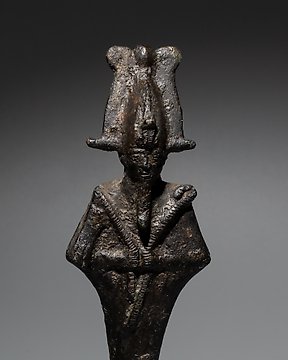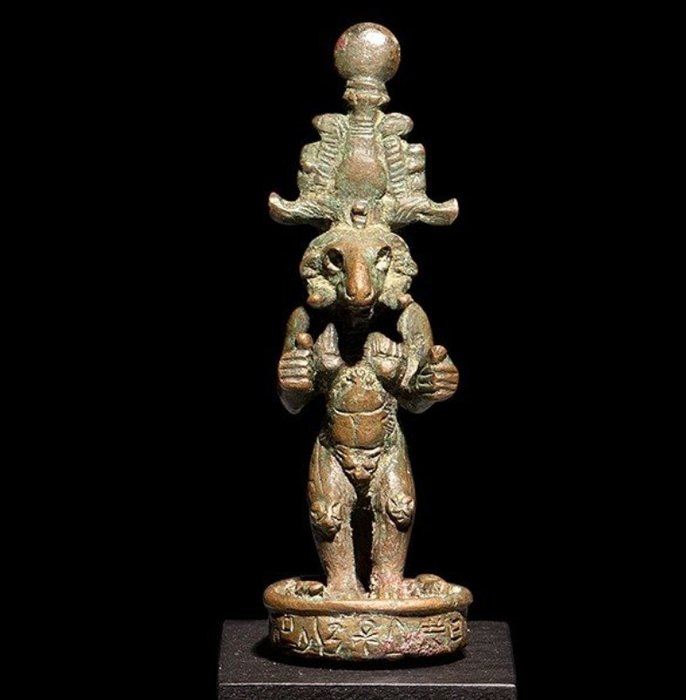
Forntida Egypten Brons Osiris Gud. Sen period, 664 - 323 f.Kr. 11,5 cm H.
Nr 83493049

Nr 83493049

Sculpture of the pantheistic apotropaic god Pamen
With Horus, Hepry, Bes, Harpokrates, Amen, Anubis gods.
Translate hieroglyphic : "May Pamen give life to Padihor son of Padiamon".
- multiple god with inscription -
- masterpiece unique -
- very rare -
CULTURE: Ancient Egypt
PERIOD: Late Period, 664 – 332 BC
MATERIAL: Solid Bronze
DIMENSIONS: Height 11.2 cm with the spike; 9.5 cm without
PROVENANCE: Private collection Brussels, Belgium, 1960 - 1970. Ex. J. Billen, Brussels.
CONDITION: Intact. Very good condition with fine details and complete hieroglyphic inscription at the base of the representation.
DESCRIPTION:
Sculpture of a multiple or pantheistic god formed from different elements of several gods. On a circular base with a hieroglyphic inscription that translates: "May Pamen give life to Padihor son of Padiamon". It presents a semi-erect human body, with a clear influence between the body of the god Bes, but more stylized, and that of the child Horus. It has the head of a ram carrying a headdress on its head, the Atef crown, composed of the White crown of Upper Egypt, topped with a solar disc, flanked by two ostrich feathers, together with an upright cobra with a solar disc on each side, and a cobra in the front part of the crown on which a large solar disk shines, just above the forehead, all these elements are supported by two twisted ram's horns. The chest is covered by a scarab, on the English and the knees three feline faces are depicted. At the rear appears a jackal's head with a tripartite wig, followed by a falcon's head from which the back of the same animal descends, covering the figure's thighs with its wings.
This sculpture is identified with an unknown multiple deity named Pamen, due to the inscription itself. Made to magically protect its owner, Padihor son of Padiamon. It is a syncretic amulet, it combines the attributes and powers of various gods, becoming the universal protector: Bes, Harpocrates, Amon, Khepri, Bastet, Anubis and Horus. Taking the body of Bes, a grotesque or terrifying-looking pygmy genie-god, the watchman of human beings in their daily lives and while they sleep. He is the apotropaic god of the home, the one who repels demons and appeases angry deities. He can be represented, as in this case, in hybrid form with various deities. Harpocrates, son of Osiris, is the weak sun of dawn, or the winter Sun, naked and unprotected. But like this Sun, he becomes a powerful Sun, and from a weak child he becomes a heroic Horus and avenger of the death of his father Osiris, at the hands of Seth. In direct relation we have the falcon, in an impossible position between the head and the back that represents the god Horus, the divinity of the cycle of regeneration and the victory of the positive forces of the universe over harmful influences. The horned ram's head represents the incarnation of Amun, the creator and regenerator who concentrates all powers. The scarab, the god Khepri, the solar god of dawn, the image of the constant transformation of existence. Felines are associated with the cat Bastet, protective goddess of the home from external threats, such as the small and medium-sized dangerous animals that lived on the banks of the Nile. Finally, Anubis, the jackal, god of the funeral and of the embalming process, protector of the necropolis, in addition to its main function, lead the soul of the deceased before the judgment of Osiris before passing to the Beyond.
Apotropaic magical rituals were practiced throughout the ancient Near East and in Ancient Egypt. The fearsome deities were invoked through rituals to protect people from evil spirits. In Ancient Egypt, these rituals performed in the home (not in state temples) were embodied by the deity who personified magic, Heka. The two deities most frequently invoked in these rituals were the hippopotamus goddess of fertility, Taueret, and the lion demon, Bes, who developed from the apotropaic dwarf demon god, Aha, literally meaning "fighter". Magical objects were often used in these rituals to facilitate communication with the gods and thus gain their protection; such as the apotropaic band of ivory with engraved images of these protective deities, small stelae of Horus as a child dominating the forces of evil represented by snakes, crocodiles and scorpions, and pantheistic sculptures with the body of Bes. In this case, two crocodiles appear at the base, one on each side of the feet, referring to the steles of Horus on the forces of evil.
All this complexity in the figure and assimilation of concepts in a single effigy is nothing more than providing the protection of all of them towards their possessor.
The technique of lost wax casting is a sculptural procedure using a mould made from a prototype of the piece to be worked, and this prototype is usually made from beeswax. This is covered with a thick layer of soft material, usually clay, which then solidifies. Once this has hardened it is put in a kiln where the wax inside melts and leaks out from expressly made holes in the clay. In its place molten metal is injected and this takes on the exact form of the mould. To remove the final piece the mould must be removed.
Notes:
The Seller can prove that the lot was obtained legally , provenance statement seen by Catawiki.
Important information. The seller guarantees that he is entitled to ship this lot.
The seller will take care that any necessary permits will be arranged.
The seller will inform the buyer about this if this takes more than a few days.
THE MINISTRY OF CULTURE FROM SPAIN ASKS ALL SELLERS FOR INVOICES OR OTHER DOCUMENTATION ABLE TO PROVE THE LEGALITY OF EACH ITEM BEFORE PROVIDING AN IMPORT OR EXPORT LICENSE.
#MorganNiquetCollection
Hur du köper på Catawiki
1. Upptäck något speciellt
2. Lägg det högsta budet
3. Gör en säker betalning